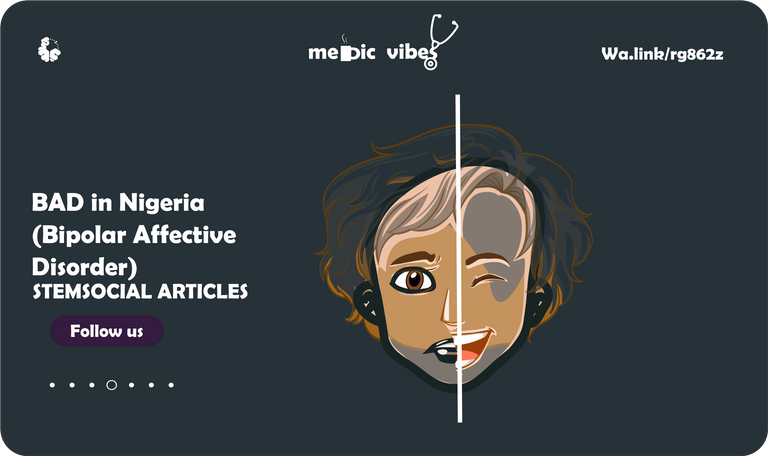BAD in Nigeria 7/7 (Limitations and Conclusions)

Inkscape.org
Depression vector created by pch.vector - www.freepik.com and
In the last post we saw the relationship between sleep parameters and depression. The features are not very predictable.
In the study, we are looking at we saw mania as a more common presentation than seen in more world-renowned studies like STEP-BP.

Inkscape.org
Depression vector created by pch.vector - www.freepik.com and
Welcome to Medic Vibes, where we discuss mental health disorders and make sense of them. Dr Ebingo Kigigha is a medical doctor (aspiring psychiatrist) and creative person (illustration and music). This has been our routine for two consecutive months. This month will be dedicated to BAD or Bipolar Affective Disorder. The first month, we discussed Depression, and in the subsequent month, anxiety. We'll begin with a discussion of a study, as we did two months ago.
In previous posts, we have introduced the study and discussed previous research describing the characteristics of Bipolar Affective Disorder. In this post, we will look at he limitation and the conclusion of this study. This research was conducted in Enugu, Nigeria. About 820 thousand people live in the state of Enugu.

Patients who are bipolar have these major depressive episodes and manic episodes. Mood disorders are also called affective disorders 2 months ago, we talked about depression, among the types of depression is Major Depressive Disorder which is otherwise known as unipolar depression.

History
King Saul's features in the bible, were typical of mood disorders when he would have David play for him in his palace. Hippocrates believed depression was a result of black bile and he called it Melancholic (meaning Black Bile). The first person to describe depression in English text was done by Robert Burton. His book Anatomy of Melancholy dates back as far back as 1621. Emil Kraepelin developed the criteria that is still used for manic-depressive psychosis. It was called folie circularie.
Demographics
Among all the mood disorders BAD I has the earliest onset. The prevalence of BAD I is equal in men and women. Episodes of mania are seen more in men while depressive episodes occur more in women. Depression appears to have a higher occurrence in rural areas, there is a tendency for schizophrenia to be misdiagnosed by practitioners from a different culture from the patient.
Other Associated Conditions
People who deal with mood disorders are significantly at risk of dealing with alcohol abuse or dependence, anxiety disorders particularly panic, obsessive-compulsive and phobias, particularly for people and socialising. Women particularly have eating disorders when they go through unipolar and bipolar disorders. Biogenic amines affect the concentration and effect of the neurotransmitters at the synaptic cleft. Cholinergic agonists modulate the activities of the pathway between the hypothalamus, Pituitary gland and adrenal gland. GABA inhibits the action of monoamine pathways that ascend especially the mesocortical and mesolimbic.
NMDA receptors bind to a receptor called N- methyl-D-aspartate (NMDA) when there is excess stimulation it leads to toxic effects on the nervous system. This may be because of the effect of glutamate's function in working against neurocognitive decline seen in recurrent severe depression as well as hypercortisolemia. Some drugs that act to synergise with GABA have a noticeable but insignificant antidepressant effect. Patients whose mood disorder is remitting and those that have close relatives have a trait that resembles the sensitivity to cholinergic agonists.
Alterations in Hormone Regulation
The studies were done with Urinary Free Cortisol, 24 house intravenous taps for plasma cortisol, cortisol in saliva and a test of feedback inhibition. There are known documentation about the changes in hormone interplay in the brain and reactions that can be a result of early life stressors. Early trauma can lead to increased hypothalamic–pituitary–adrenal(HPA) activity which is followed by cerebral cortex volume depletion and cellular reduction. HPA activity is being referred to as a clear feature of mammalian stress and it is a link between depression and the biology of chronic stress. 60% of the time cortisol is not suppressed in the morning or it escapes suppression by 4 pm.
This test does not provide a diagnosis for mood disorders because the same results are seen in mania and other psychiatric conditions. 5 to 10% of those who are depressed usually have a thyroid abnormality, this is seen in the amount of thyroid-stimulating hormone or the fact that there is an abnormally high reaction to 500 mg of hypothalamic neuropeptide thyroid releasing hormone. Prolactin is a hormone released in response to serotonin stimulus and inhibited by dopamine stimulus. So far there has not been any major correlation between prolactin and depression.
There are associated sleep patterns in depression The characteristics of this easy arousal are longer periods of nighttime awakeness, reduced sleep time, an increase in the Rapid Eye Movement (REM) phase of sleep and a rise in body temperature. Reduced secretion of growth hormone is linked with this reduced slow wave sleep. In 40% of outpatients with depression and 80% of inpatients, it is seen. This is because there is increased REM drive and reduced fast-wave sleep that results in a reduced first period of non-Rapid Eye movement (NREM). There is a reduction in REM latency this is because there is increased REM drive and reduced slow wave sleep that results in a reduced first period of non-Rapid Eye movement (NREM).
Imaging in Mood disorders
With the use of COmputerised Axial Tomography and Magnetic Resonance Imaging, we have been able to see live images of the human brain while mood disorder is present. The areas being studied are the cortex, subcortex and areas of white matter.
What has been observed in depression is an increased occurrence of hyperintensities in the subcortical region. The areas include the areas around the ventricles, the basal ganglia and the thalamus.
These hyperintensities are seen more frequently in BAD I and elderly patients and are evidence of neurodegenerative affectation of the brain due to mood disorders.
Some studies showed findings of enlargement of the ventricles, cellular reduction in the cells of the cerebral cortex, and widening of the spaces between the folds of the brain (widened sulci).
In depressed patients, there are findings of reduced volume in the hippocampal or caudate nucleus showing that there are deficiencies in the neurobehavioural systems. Different areas show focal and diffused atrophy and this has been shown to have correlations with how bad the condition is, the level of bipolarity and a high level of stress hormone.
Positron Emission Tomography shows that the anterior parts of the brain have decreased metabolic activity in depression. This decrease in metabolism is seen more on the left than on the right. Some others view brain activity from another angle and feel that depression might be an increase in non-dominant hemisphere activities. When there is a shift from depression to hypomania in bipolar disorder there is a change from the reduced frontal activity in such a way that there is greater right hemisphere reduction in mania than in depression where there is greater left hemisphere reduction.
Some studies have also shown a reduction in blood flow to the cerebrum and/or reduced metabolism in mesolimbic and mesocortical systems that have dopaminergic nerves in depression.
What has been found about antidepressants is that they can partially fix these changes. Another change in function found in those with depression is increased metabolism of glucose, in the limbic regions, especially in those with severe depression who have close family members who have mood disorders. The reason behind these findings is related to the increased rumination seen in depression.

The Limitations and Conclusions

Inkscape.org
Image by brgfx on Freepik
Limitations
The methods used for this study were similar to STEP-BD and SFBN but do not have the complexities seen in field standard studies. One of the reasons is because of the resource-poor setting that these studies are done in and the fact that the studies are not funded. Another reason for this because of the lack of human resources to do these studies. The last reason is that the materials necessary to accomplish the height of these world-renowned studies are simply not available.
I must however commend the effort of the team under Mbadiwe Onyeama et al. For putting forward this effort. The results of this study are not a direct representation of the Bipolar population in the Southeastern state but it is a good estimation.
Another very important limitation is the fact that psychiatric hospitals are not the first choice for bipolar patients. This is because many would prefer traditional healers and houses of prayer to orthodox medicine. Also, the patient’s relatives leave the hospital to find other options for treatment.
That is why the population in the study do give a clear application to the whole, these are simply just a few that are available for treatment.
Another factor to consider is the fact that the patients in this study may have been wrongly diagnosed with BAD and this is the case in other studies and could be the case in this study.
Lastly are missing values in this study that simply could not be assessed.
Conclusions
This study did what it was supposed to do and that was to examine the cases of BAD in the geographic area of the study at the particular time.
The findings of this study resemble those seen in developed countries and developing countries at the same time.
To make a more inclusive study, it would be best to find a sample population that represents the real population on the ground.

Tips
Behavioural therapy relies on the fact that there is reinforcing feedback and a lack of acceptance from society as a result of poor adaptation. When this poor adaptation is fixed the patient behaviour in society leads to better reinforcements.
Behavioural Therapy has not been thoroughly studied for major depression.

Hive Stories
@zirochka takes a stroll round a very big psychiatry hospital in Ukraine and has some pictures to share. The images are thought provoking and makes you wander how that hospital functioned before this war.
Read this post here
Questions
- What did you learn about mood disorders?
- What did you learn about Bipolar disorder?
- What's the most interesting aspect of this study?
Conclusion
Imagne can reveal som of the changes that take pace in mood disorders and but they are not diagnostically specific. There are several features that give pointers to the changes that occur.
There were several limitations to the study that made it not reveal the total picture seen everywhere else in the world.
Behavioural therapy may not be very effective for doctors hoping to see good results in therapy as studies on this method have not been very useful.

I hope that you learned a lot from this post.
To book me for illustration gigs click Here
References
- Kaplan-Sadocks-Comprehensive-Textbook-Psychiatry
- Psychiatria
- Page demarcations made with Inkscape.org
@tipu curate
Upvoted 👌 (Mana: 4/34) Liquid rewards.
@ebingo, this post is very complete, I really liked it.
Share great, well-founded information here.
And that is not only limited to talking about what the classic signs of a bipolar disorder are, but also the metabolic that is implicit in this pathology.
You are talking about history, which is not something that has been recently discovered, but that was already reviewed in the time of Hippocrates.
interesting? the whole post. thanks
@apineda thank you so much for stopping by and supporting us.
Yes there are a lot of metabolic changes in mood disorders. While studying to write this post I found that there is increased glucose metabolism in the limbic regions because of rumination. This information is so practical in useful for the reason there is fatigue in depression but also is proof that that there is rumination.
Yes. Historically there were many who ere believed to have suffered from depression. King Saul who would constantly abuse David this bible was one.
Thanks for your contribution to the STEMsocial community. Feel free to join us on discord to get to know the rest of us!
Please consider delegating to the @stemsocial account (85% of the curation rewards are returned).
You may also include @stemsocial as a beneficiary of the rewards of this post to get a stronger support.
So much physics is hidden in this post… ;)
But I guess my biggest surprise was the following:
This was definitely unexpected. Glad to have learned about the origins of this word!
Lol... Maybe we can have an episode where you expand on that thought?
Well... probably not as this is not something with which I play on an every day basis, and I don't teach it either (although I did it when I was 25).
Ohh...That's cool. Your career has been years in the making. Kudos to you...
Totally: more than two decades :D
I didn't quite understand the increased metabolism being as a result of increased rumination.
I have always thought they would be decreased.